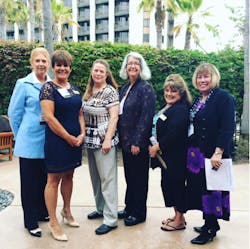This article was updated by the author at 7:30 am EDT on June 3rd.
This article was also updated at 2 pm EDT on June 8th to include a statement from the American Dental Hygienists' Association.
Members of CDHA’s executive leadership pose for Facebook photo in San Diego.
When the California Dental Hygienists’ Association elected to withdraw from the American Dental Hygienists’ Association in 2016, downtown Fresno, which hosted the state’s top dental hygiene officials, was in the middle of a heat wave where the temperatures soared above 100 degrees for seven days—easily a dozen or so degrees warmer than average for the inland agricultural center in California.
In contrast, the state dental hygiene association’s house of delegates meeting last weekend occurred where it was much cooler. Temperatures in the low 70s is common for this time of year in San Diego.
It’s not fair to compare the two climate settings to any psychological temperaments. While things were tense during the CDHA’s refusal to sign a charter agreement with the national association in 2016, the extreme emotions could probably be described as dismay by the state’s diehard ADHA supporters and a nervous resolve among the majority of hygienists who felt it was simply time for a change.
-------------------------------------
From 2016 coverage on DentistryIQ:California hygienists confirm board decision to not sign ADHA agreement
-------------------------------------
But it is noteworthy that the association’s first house of delegates meeting as an independent entity was at a Hyatt surrounded by marinas and hundreds of Californians’ playthings—boats of every description. And, there was that pleasant ocean breeze fostering a sense of good will among the approximately 200 hygienists and 100 dental hygiene students who attended the meeting.
For example, Julie Coan, the CDHA president, pronounced the meeting as a celebration of the “first anniversary as an independent professional organization,” asking the delegates and guests to sing along in a rendition of “Happy Anniversary to Us.”
The American Dental Hygienists’ Association, by the way, did have representation. Coan made it a point to acknowledge Betty Kabel, a Florida dental hygienist who is the national association’s current president, and Tammy Filipiak, the ADHA president-elect who hails from Wisconsin. Coan said she appreciated a discussion with Kabel and Ann Battrell, the ADHA executive director, a few weeks before the house of delegates meeting.
But make no mistake about it: “This has been a year of firsts,” according to Coan.
She explained that the independent state association faced the challenge of informing dental hygienists throughout California, including nonmembers, about the changes with the association. The CDHA expanded its management staff and engaged in “collaboration” with the state’s governmental offices and the California Dental Association to promote the profession as a viable workforce in the state, as well as to address specific labor law issues.
The dental hygiene association desires to be an active participant in addressing access to care for California’s “diverse populations.” “The passion resides in all of us,” Coan told her peers in California.
After the San Diego meeting, the ADHA released a statement:
Last week, June 2-4, Betty Kabel, RDH, BS, president, and Tammy Filipiak, RDH, MS, president-elect of the American Dental Hygienists’ Association (ADHA) were invited guests at the House of Delegates meeting for the California Dental Hygienists’ Association. During the CDHA meeting, the ADHA leaders were publicly introduced and greeted warmly.
“ADHA’s strategic plan is anchored by three pillars—Unite, Empower and Support. This applies to all dental hygienists in the U.S.,” said Kabel. “We continue to extend an open invitation to our colleagues in California and welcome them to participate in all aspects of ADHA. We are pleased to see that a large number of dental hygienists from California continue to support ADHA through their national membership and are engaged participants in various aspects of the organization.”
As with any type of organization, the key is momentum. Despite the promising start, which included educational efforts through social media and old-fashioned campaigning with visits to dental hygiene schools and constituent societies, the CDHA faces the same challenge as any other professional trade association—recruiting and retaining membership.
Some California dental hygienists were disappointed by the 2016 decision in Fresno. They opted to instead remain loyal to their ADHA membership. All state dental hygiene associations, though, generally acknowledge the difficulties in persuading practicing dental hygienists to set aside dues for membership in an association.
The CDHA’s initial drive for momentum has focused on workplace issues of concern to dental hygienists. For example, Coan said the association “got a great offer” on discounted disability insurance for its members. Again, though, the insurer does have enrollment expectations for CDHA members. The 60-day enrollment period concludes in June, and the association was an exhibitor at its own house of delegates meeting to tout the benefits of the insurance program.
The association's inaugural leadership fostered the intiatives. Coan has formed a close working relationship with Lygia Jolley, the past president who oversaw the historic vote that occurred in Fresno, and Lory Laughter, who became the CDHA’s president by the end of the weekend at the San Diego house of delegates meeting. “I’ve called them early in the morning and I’ve called them late at night,” Coan said of the other two dental hygienists.
Jolley is based in Visalia, which lies in the San Joaquin Valley between Fresno and Bakersfield. Laughter lives north of San Francisco in the Napa Valley area. Coan is based in a suburban area south of Oakland. Together, the trio, along with other members of the state association’s executive committee and CDHA staff, have reached out to hygienists throughout the country’s third largest state.
Coan believes the association will be ready to move forward on advancing more professional or health-care issues relevant to California once the independent association becomes more established.
The CDHA, however, is a democratic association, meaning the state’s dental hygienists could elect officials in the future who would gradually lean the association back toward reuniting with the ADHA.
The scramble for membership in California Dental Hygienists’ Association continues, with the hope that it will sustain its independence.







